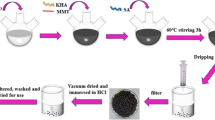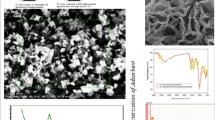Abstract
The “3-in-1 type” biopolymer composite (chitosan/montmorillonite clay/biosorbent) hydrogels were produced and used as adsorbents for Cr(VI) ion. Na-Montmorillonite (NaMMT) clay was modified with Spirulina (Sp) biosorbent by using lyophilization based “cryoscopic expansion” (C-XP) method. The Sp immobilized MMT (SpMMT) clay containing hydrogels were found to have an open/extended form of Sp structure on their pores’ walls, presenting all possible receptor groups for adsorption of Cr(VI) ions. SpMMT loaded hydrogels showed higher adsorption capacities than NaMMT loaded ones. The physically crosslinked hydrogel including only 1% SpMMT (1SpM-H) clay exhibited 150% higher adsorption capacity as compared to neat chitosan hydrogel even in 50 ppm Cr(VI) solution. The same composite hydrogel was found to adsorp about 780% Cr(VI) with respect to the clay’s weight while individual uses of Sp and MMT can remove only about 4.80 and 0.36% Cr(VI) with respect to their weights. The pseudo-first order model was found to be the most suitable for the kinetic data of NaMMT loaded hydrogels while that of SpMMT containing hydrogels followed the pseudo-second order kinetics. The isotherm data of all the hydrogels exhibited a better fit to the Freundlich and Sips model. The maximum adsorption capacity (3333 mg g−1) calculated by Sips model was achieved via the hydrogel having 1% SpMMT which is in good agreement with the experimental kinetic data. The highest adsorption with the lowest amount of SpMMT clay could be attributed to its looser Sp network structure whose functional groups are in long-distance, releasing more adsorption sites for the Cr(VI). The highest compression modulus and toughness were also obtained with the 1SpM-H hydrogel which is probably due to increased physical and reversible interactions between chitosan molecules and SpMMT clay layers at optimum clay loading (1%).















Similar content being viewed by others
References
Yusof AM, Malek NANN (2009) J Hazard Mater 162:1019
Bai S, Abraham TE (2001) Bioresour Technol 79:73
Prigione V, Zerlottin M, Refosco D, Tigini V, Anastasi A, Varese GC (2009) Bioresour Technol 100:2770
Gupta V, Rastogi A (2009) J Hazard Mater 163:396
Maryuk O, Pikus S, Majdan M, Skrzypek H, Zięba E (2005) Mater Lett 59:2015
Aydınoğlu D, Akgül Ö, Bayram V, Şen S (2014) Polym Plast Technol Eng 53:1706
Nasernejad B, Zadeh TE, Pour BB, Bygi ME, Zamani A (2005) Process Biochem 40:1319
Tekay E, Şen S, Aydınoğlu D, Nugay N (2016) e-Polymers 16:15–24
Arunakumara K, Zhang X, Song X (2008) JOUC 7:397
Chojnacka K, Chojnacki A, Gorecka H (2005) Chemosphere 59:75
Doshi H, Ray A, Kothari I (2007) Biotechnol Bioeng 96:1051
Wang W, Zhao Y, Yi H, Chen T, Kang S, Li H, Song S (2017) Nanotechnology 29:025605
Kang S, Zhao Y, Wang W, Zhang T, Chen T, Yi H, Rao F, Song S (2018) Appl Surf Sci 448:203
Wang W, Zhao Y, Bai H, Zhang T, Ibarra-Galvan V, Song S (2018) Carbohydr Polym 198:518
Hoffman AS (2012) Adv Drug Deliv Rev 64:18
Wang X, Du Y, Luo J, Lin B, Kennedy JF (2007) Carbohydr Polym 69:41
Wang M (2003) Biomaterials 24:2133
Kithva P, Grøndahl L, Martin D, Trau M (2010) J Mater Chem 20:381
Lavorgna M, Piscitelli F, Mangiacapra P, Buonocore GG (2010) Carbohydr Polym 82:291
Tang C, Xiang L, Su J, Wang K, Yang C, Zhang Q, Fu Q (2008) J Phys Chem B 112:3876
Díaz-Visurraga J, Melendrez M, Garcia A, Paulraj M, Cardenas G (2010) J Appl Polym Sci 116:3503
Yang X, Tu Y, Li L, Shang S, Tao X (2010) ACS Appl Mater Interfaces 2:1707
Mert HH, Tekay E, Nugay N, Nugay T, Şen S (2018) Polym Eng Sci 58:1229
Kummer G, Schonhart C, Fernandes M, Dotto G, Missio A, Bertuol D, Tanabe E (2018) J Polym Environ 26:4073
Eaton ADCLS, Greenberg AE, Franson MAH (2005) In: Eaton AD (ed) Standard methods for the examination of water and wastewater. American public health association, Washington DC, p 49
Palantöken S, Tekay E, Şen S, Nugay T, Nugay N (2016) Polym Compos 37:2770
Tu J, Cao Z, Jing Y, Fan C, Zhang C, Liao L, Liu L (2013) Compos Sci Technol 85:126
Liu M, Wu C, Jiao Y, Xiong S, Zhou C (2013) J Mater Chem B 1:2078
Ansari R, Delavar AF (2010) J Polym Environ 18:202
Vachoud L, Zydowicz N, Domard A (1997) Carbohydr Res 302:169
Dotto G, Lima E, Pinto L (2012) Bioresour Technol 103:123
Mahl CR, Taketa TB, Bataglioli RA, de Arruda EJ, Beppu MM (2018) J Polym Environ 26:4338
Theivarasu C, Mylsamy S (2010) Int J Eng Sci Technol 2:6284
Akar ST, Yetimoglu Y, Gedikbey T (2009) Desalination 244:97
Hoffman AS (2002) Adv Drug Deliv Rev 54:3
Helvacıoğlu E, Aydın V, Nugay T, Nugay N, Uluocak BG, Şen S (2011) J Polym Res 18:2341
Acknowledgements
The financial support provided by Yalova University Scientific Research Projects Coordination Department (project no. 2015/BAP/117) is gratefully acknowledged.
Author information
Authors and Affiliations
Corresponding author
Ethics declarations
Conflict of interest
The authors declare that they have no conflict of interest.
Additional information
Publisher's Note
Springer Nature remains neutral with regard to jurisdictional claims in published maps and institutional affiliations.
Rights and permissions
About this article
Cite this article
Tekay, E., Aydınoğlu, D. & Şen, S. Effective Adsorption of Cr(VI) by High Strength Chitosan/Montmorillonite Composite Hydrogels Involving Spirulina Biomass/Microalgae. J Polym Environ 27, 1828–1842 (2019). https://doi.org/10.1007/s10924-019-01481-4
Published:
Issue Date:
DOI: https://doi.org/10.1007/s10924-019-01481-4




